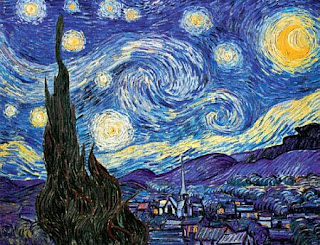Bright Night
This game is about the painting "Starry Night" by Van Gogh, the board game conveys the emotions, themes, and atmosphere of the painting.
Player:
2-4; Ages 13 and up for artistic gamers and aspiring artists.Play time:
2-8 minutes.Components:
1 dice, 140 brightness pieces included, 9 star pieces, 4 player pieces, 1 game board.Setup Phase:
- Players first decide on if they are playing competitive or co-operative game play.
- Each player starts with 15 brightness pieces.
- Each of the 9 loose stars are placed randomly (or however the player decides) on tiles around the map.
- Each player starts in a corner of the map.
- No talking or communicating during the game. (unless explaining rules)
Objective:
Players can choose to play with either goal:
- Co-op: The goal is for all the players to lose their brightness with in 2 turn of each other, after collecting all of the loose stars on the board.
- Competitive: The goal is to have the most brightness after all the stars are collected. Players leave a trail of brightness pieces as they move along paths.
Game Turns:
- Players roll a dice to decide how much they can move.
- Players can move horizontally, vertically or a combination of both any amount of times in 1 turn (Moving the number of spaces of their roll as the max, can move less than the rolled number).
- Each time a player moves a square, depending on the tile type they move over, the player loses brightness accordingly (Player needs to move at least 1 space per turn).
- There are 3 tile types: Darkest, dim and bright. They can be seen as the brightness of each tile on the game board (Bright tile is the one that is glowing on each side of the tile).
- Players lose 3 brightness if they move over on to the darkest tile, 2 brightness if they move over a dim tile and 1 brightness if they move over to the lightest tile (has a light glow).
- Player cannot pass over or occupy the same square as another player.
- When a player collects a loose star on the board, it is removed and that player gains 7 brightness + their dice roll (Ex. a player rolls a 4 and moves to the tile with the star, that player gain 7 + 4 brightness which is 11).
- In competitive mode, players only need to spend 1 brightness to move a tile, regardless of the tile type. Each square the player moves they must leave behind a brightness piece. If a player moves on a path that already has a brightness piece on it, they don't need to put their own brightness down.
Ending Condition:
In co-operative mode, all stars need to be collected for the
players to win. After the stars are collected, all players need to lose all of
their brightness within 2 turns of the first person to lose their brightness. All players win if these criteria are met.
In competitive mode, the game ends as soon as the last star is taken,
players count their brightness pieces and the player with the most wins.
A common
strategy for co-op is for players with higher brightness than others to move
around and aim for darker tiles, so they lose brightness faster to even out the
balance in brightness levels towards other players. Since player’s aren't allowed to communicate during the game, they need to figure out some way to
even out how distribute all the loose stars on the map evenly.

















